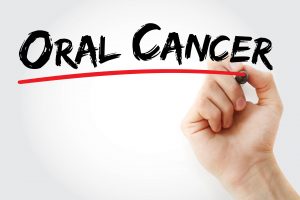
Oral cancer sign
Tiny spots or sores that appear in the mouth are often completely harmless and heal or fade on their own. However, sometimes those tiny spots or sores may be the sign of something quite serious: oral cancer. Detecting this deadly disease early is key to overcoming it – indeed, the National Institute of Dental and Craniofacial Research reports that the five-year survival rate for those diagnosed with oral cancer early is 75%, while only 20% for those in whom cancer has spread.
April is Oral Cancer Awareness Month, so there is no better time than now to learn how partnering with a dentist in Washington, D.C. can help you spot oral cancer early and boost your chances for successful treatment.
What is Oral Cancer?
Oral cancer refers to any cancer that occurs in the mouth and parts of the throat, including the lips, tongue, gums, inside of the mouth, esophagus, tonsils and middle region of the throat.
These types of cancer are quite common – indeed, according to the National Institutes of Health, oral cancers represent the sixth most common cancers in the world.
Warning signs and symptoms of oral cancer include:
- Red or white dots or patches of skin
- Lumps or thickened areas of skin inside the mouth
- Ear pain
- Unexplained mouth pain
- Loose teeth
- Difficulty swallowing
How to Lower Your Risk of Oral Cancer
You can lower your risk for oral cancer by doing the following:
- Be vigilant and watch for changes in the soft tissues of your mouth
- Avoid all tobacco products
- Avoid heavy alcohol use
- Visit your dentist for regular oral cancer screenings
What to Expect During an Oral Cancer Screening
Your dentist typically checks your mouth, face and neck for signs of oral cancer during every routine dental checkup. A full oral cancer screening usually includes the following:
- Visual examination of the mouth using special observation tools – such as a tongue depressor and small lights – for signs of oral cancer
- Manual examination of the mouth, face and neck for unusual bumps and masses
- Targeted questions to understand patient’s exposure to oral cancer risk factors (e.g., smoking tobacco)
- Targeted questions to help identify nonvisible symptoms of oral cancer, such as a sore throat or scratchy voice
How Often Should I See a Dentist?
The American Dental Association recommends seeing a dentist every six months for a routine dental checkup.
In addition to checking your mouth for signs of oral cancer, a dentist or dental hygienist will expertly clean your teeth, removing harmful plaque and tartar buildup that could contribute to tooth decay. Your dentist may also take X-rays of your teeth in order to spot underlying problems invisible to the naked eye.
From early detection of oral cancer to being able to walk out of the dentist’s office with a mouth that feels clean and refreshed, there is no reason to avoid seeing the dentist on a regular basis! Talk to a dentist in Washington, D.C. today.
About the Author
Dr. Yelena Obholz believes learning is a lifelong pursuit, which is why she is currently enrolled in continuing education classes at the prestigious Las Vegas Institute for Advanced Dental Studies. The New York University College of Dentistry graduate also ensures her Washington, D.C. private practice stays updated with the latest in dental technology. Patients old and new can contact Dr. Obholz via her website or by calling 202-364-8989.
